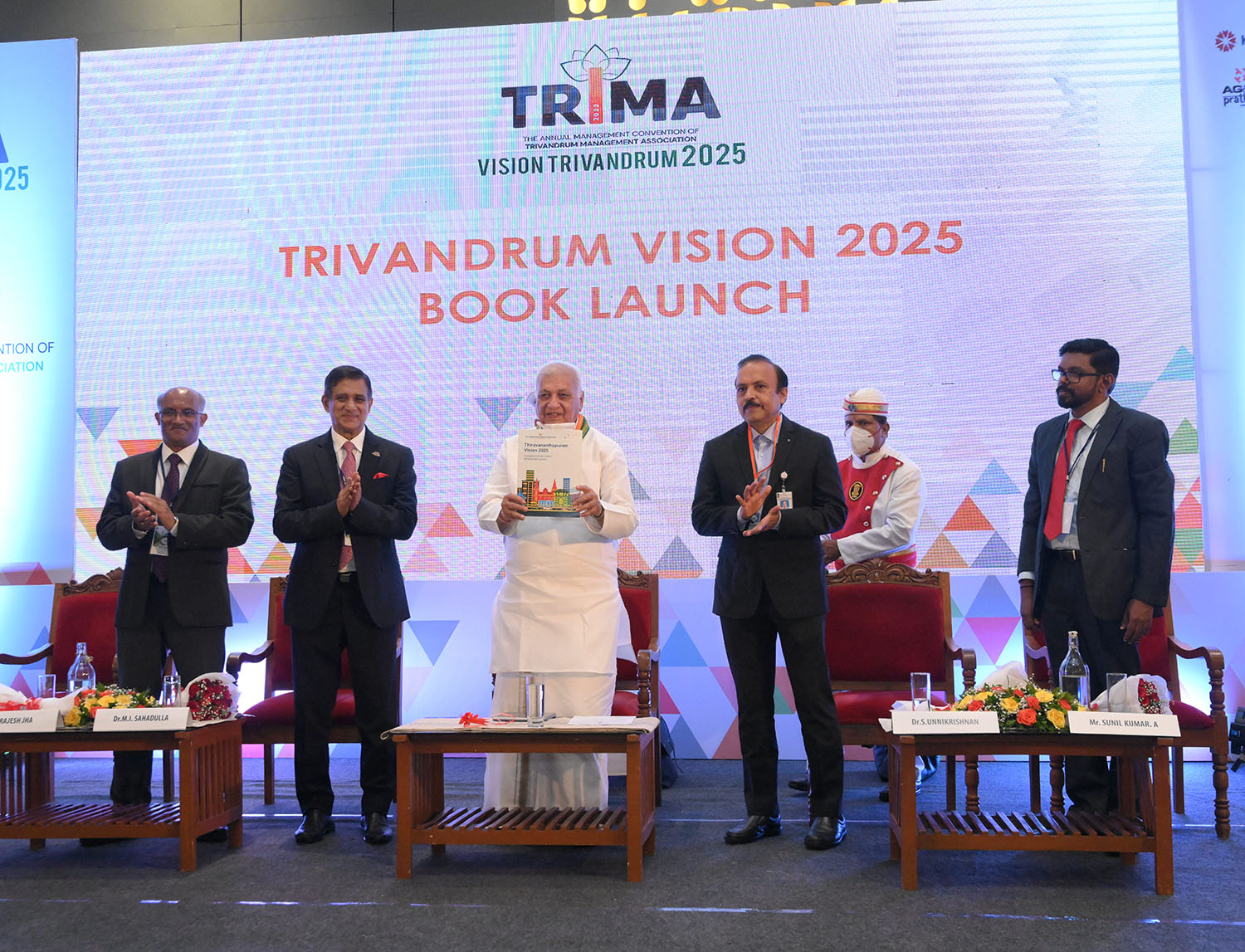TMA’s vision document calls for building a brand identity for the capital city
TMA’s vision document calls for building a brand identity for the capital city
Trivandrum / June 11, 2022
Thiruvananthapuram, June 11: Despite its exponential growth in Tourism, IT sector and Healthcare delivery, Kerala capital Thiruvananthapuram needs to embark on a sustainable development vision to become a world-class inspirational city with best-in-class infrastructure and efficient human capital, says “Trivandrum Vision 2025 – A Snapshot of city’s vision development journey’, brought out by Trivandrum Management Association (TMA).
Kerala Governor Shri Arif Mohammed Khan released the book last evening at the Inaugural session of TRIMA 2022, TMA’s Annual Management Convention. The document is an outcome of wide consultations involving 6,000 participants and held among multiple city development initiatives and forums.
Prepared in association with G Vijaya Raghavan’s Nammude Thiruvananthapuram Survey for Top 25 projects, the book is a four-year vision document, tempered with an actionable roadmap, measurable outcomes and even funding sources from public and private sectors, for future development of the city.
The 64-page blueprint, prepared by KPMG, makes a strong case for the city to build a brand identity similar to that of Bengaluru, New York, London and Amsterdam, which could, in turn, stimulate its economy and make it even more popular.
TMA President Rajesh Jha said over the last few decades, Thiruvananthapuram has grown manifold in terms of its economy and population, and is known for its tourist attractions, high-quality infrastructure, a vibrant hub for IT parks, and talented human capital.
“However, it has now become imperative to moot an actionable development agenda for facilitating its transition into a sustainably developed city with efficient human capital, robust infrastructure and improved livability,” he explained.
Pointing out that the sustainable development of Thiruvananthapuram will require multi-sectoral, multi-disciplinary and multi-stakeholder collaboration, the document prescribes five key pillars for accelerating the city’s growth trajectory: Sustainable Development, Human Capital, Seamless Connectivity, World Class Infrastructure and Improved Liveability. It also makes a detailed analysis of goals, wish list, and opportunities in various sectors, along with the implementation framework.
Thiruvananthapuram needs to become a prosperous city where the average GDP per capita is four times the current number, the unemployment rate is reduced by 95 per cent, the inflation rate is lesser than the national inflation rates, pollution levels drop by 95 per cent of the current levels, and is a zero-poverty region, it says.
For instance, the report calls for integrated tourism development to make the city rank among the top 25 tourist hotspots in the world, achieve a five-fold increase in footfalls in the district and ten-fold increase in the revenue. This can be achieved by developing the city into a heritage tourism site by restoring old palaces and other monuments; branding of Balaramapuram handloom and weaver’s village as a tourist destination; promoting MICE in the district to attract more corporate tourists; launching Kovalam on a global platform to position it as an unparalleled global beach destination; and ensuring proper connectivity to all tourist attractions (like Dubai is connected to all tourist attractions by metro). It also calls upon the government to implement an Annual Tourism Infrastructure Fund.
The vision document envisages setting at least one satellite campus of an Ivy League university by 2025, launching the state’s first Digital University and an Advanced Skill Development Centre (Knowledge City) to create a skilled population; increasing usage of solar power in households, commercial establishments, and government offices by 50 per cent, and reducing per capita waste production by 75 per cent.
Some other measures include attracting an IPL team with Thiruvananthapuram as its home base or creating an extended hub for Kerala Blasters; establishing a high court bench; developing an industrial corridor for smooth access to the industrial production units; and ensuring seamless connectivity to the city to make it the leading mobility hub in South India across air, rail, road, and water.
The document sets clear and measurable goals across different sectors and details out the composition of the Development Committee with stakeholders from the government, industry bodies, management forums and local government groups, and the tasks which would be undertaken by them.
Photo Gallery

